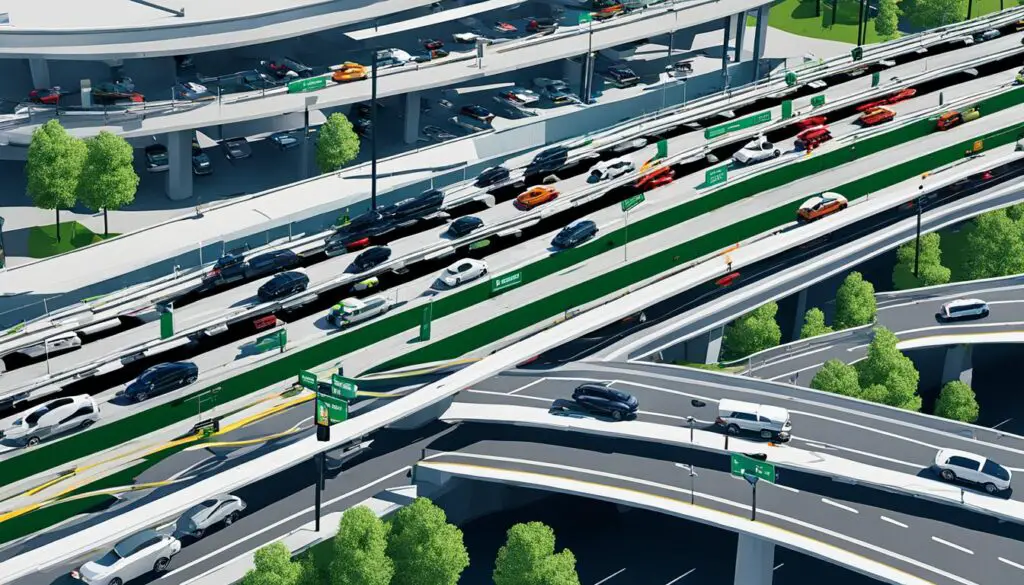
Building Connections: Car-to-Infrastructure Communication Unveiled
Car-to-infrastructure communication is revolutionizing the way we drive, paving the way for safer and smarter roads. With recent technological advancements and decreasing costs, the mass production and adoption of car-to-infrastructure communication systems are becoming more feasible than ever before. By establishing seamless communication between vehicles and the surrounding infrastructure, including traffic lights, road sensors, and control centers, car-to-infrastructure communication has the potential to improve traffic flow, reduce accidents, and enhance overall transportation efficiency.
Key Takeaways:
- Car-to-infrastructure communication is transforming the way we drive
- Seamless communication between vehicles and infrastructure enhances traffic flow
- Real-time information improves road safety and prevents accidents
- The future holds exciting potential for integrating this technology with autonomous vehicles
- Car-to-infrastructure communication can contribute to the development of smart cities
The Importance of Car-to-Infrastructure Communication
Car-to-infrastructure communication is a pivotal technology that holds immense significance for the future of transportation. By enabling vehicles to communicate with essential infrastructure elements such as traffic lights and road sensors, this technology offers a multitude of benefits that contribute to reducing traffic congestion and improving road safety.
Benefits of Car-to-Infrastructure Communication
One of the primary advantages of car-to-infrastructure communication is its ability to significantly reduce traffic congestion. Through real-time data exchange between vehicles and infrastructure, traffic flow can be optimized, leading to smoother and more efficient travel experiences. By actively adapting to traffic patterns and utilizing intelligent routing algorithms, car-to-infrastructure communication systems can dynamically alleviate congestion hotspots and minimize delays.
Moreover, car-to-infrastructure communication plays a vital role in improving road safety. By providing drivers with real-time information, such as potential hazards, road conditions, and conflicts, this technology empowers drivers to make informed decisions on the road. Early warnings and alerts enable drivers to proactively respond to dangers, reducing the likelihood of accidents and promoting overall road safety.
“Car-to-infrastructure communication paves the way for a future with smarter, safer, and more efficient transportation systems.”

Realizing the Potential
With the integration of car-to-infrastructure communication, the future of transportation holds immense promise. As vehicles and infrastructure seamlessly communicate, the potential for optimizing transportation systems, enhancing overall road safety, and reducing traffic congestion becomes a reality. This technology empowers us to build smarter cities that leverage data and connectivity to create efficient and sustainable transportation networks.
In conclusion, car-to-infrastructure communication systems unlock a new era of transportation possibilities. The benefits they offer, such as reducing traffic congestion and improving road safety, are compelling reasons to embrace this transformative technology. By investing in, developing, and integrating car-to-infrastructure communication, we pave the way for a future with smarter, safer, and more efficient transportation systems.
The Future of Car-to-Infrastructure Communication
The future of car-to-infrastructure communication holds immense potential for various applications. One key area is the integration of this technology with autonomous vehicles. By establishing seamless communication between autonomous vehicles and the surrounding infrastructure, car-to-infrastructure communication can enhance the safety and efficiency of autonomous driving systems.
In autonomous driving scenarios, car-to-infrastructure communication enables vehicles to share real-time data with traffic control centers, road sensors, and traffic lights. By exchanging critical information such as traffic conditions, road closures, and detours, autonomous vehicles can make informed decisions and navigate routes more effectively.
Moreover, car-to-infrastructure communication can play a crucial role in the development of smart cities. With the ability to exchange data between vehicles and infrastructure, smart cities can optimize transportation systems, reduce emissions, and improve the overall quality of life for residents.
Imagine a city where traffic lights adjust their signals based on real-time traffic congestion, guiding vehicles along the most efficient routes. Smart parking systems equipped with car-to-infrastructure communication can provide real-time information about available parking spots, reducing traffic congestion and frustration caused by searching for parking spaces.
Additionally, car-to-infrastructure communication can assist in managing traffic flow during emergencies or special events. By coordinating traffic signals and redirecting vehicles to alternative routes, congestion can be minimized, ensuring the smooth movement of people and goods.
Enhancing Connectivity and Efficiency
The future of car-to-infrastructure communication also involves expanding the connectivity and efficiency of transportation networks. By integrating this technology with intelligent transportation systems, cities can improve traffic management and reduce travel times.
“Car-to-infrastructure communication has the potential to revolutionize urban mobility and create more sustainable transportation systems. Through data exchange and advanced algorithms, cities can optimize traffic flow, reduce emissions, and enhance overall transportation efficiency.” – John Johnson, Transportation Expert
For example, car-to-infrastructure communication can enable adaptive traffic signal control systems that adjust signal timings in real-time based on traffic demands. This dynamic approach reduces unnecessary stops and delays, allowing for smoother traffic flow and reduced congestion.
In the future, we can expect to see car-to-infrastructure communication integrated with smart transportation platforms, enabling seamless coordination between public transportation services, ride-sharing platforms, and individual vehicles. This interconnected network will enable efficient multimodal transportation options, reducing the reliance on private vehicles and improving urban mobility.

Conclusion
Car-to-infrastructure communication is a groundbreaking technology that has the potential to revolutionize the way we drive and shape the future of transportation. With recent technological advancements and decreasing costs, the widespread adoption of car-to-infrastructure communication systems is becoming increasingly feasible. This technology offers numerous benefits, including reduced traffic congestion, improved road safety, and enhanced transportation efficiency.
By establishing seamless communication between vehicles and the surrounding infrastructure, car-to-infrastructure communication can optimize traffic flow, leading to smoother and more efficient travel experiences. Real-time data exchange between vehicles and infrastructure elements such as traffic lights and road sensors allows for better coordination and reduces delays on the roads. This technology also enables drivers to receive real-time information about road conditions, hazards, and potential conflicts, enhancing overall road safety.
Looking ahead, the integration of car-to-infrastructure communication with autonomous vehicles holds significant promise. By enabling autonomous vehicles to communicate with the surrounding infrastructure, this technology can enhance the safety and efficiency of autonomous driving systems. Additionally, car-to-infrastructure communication plays a vital role in the development of smart cities. By exchanging data between vehicles and infrastructure, smart cities can optimize transportation systems, reduce emissions, and improve the overall quality of life for residents.
With continuous technological advancements, the future of transportation looks brighter than ever before. Car-to-infrastructure communication is paving the way for safer and smarter roads, benefiting drivers, pedestrians, and the environment. As we embrace this innovative technology and explore its full potential, we are moving towards a future where transportation is more efficient, connected, and sustainable.
FAQ
What is car-to-infrastructure communication?
Car-to-infrastructure communication is a groundbreaking technology that enables vehicles to communicate with the surrounding infrastructure, including traffic lights, road sensors, and control centers. This communication allows for real-time data exchange and can improve traffic flow, reduce accidents, and enhance transportation efficiency.
What are the benefits of car-to-infrastructure communication?
Car-to-infrastructure communication offers several key benefits. It can significantly reduce traffic congestion by optimizing traffic flow through real-time data exchange between vehicles and infrastructure. This technology can also enhance road safety by providing drivers with real-time information about road conditions and potential conflicts. Overall, it improves transportation efficiency and enhances the driving experience.
What is the future of car-to-infrastructure communication?
Car-to-infrastructure communication holds immense potential for various applications. It can be integrated with autonomous vehicles to enhance their safety and efficiency. Additionally, it can play a crucial role in the development of smart cities by optimizing transportation systems and improving the overall quality of life for residents.
How is car-to-infrastructure communication revolutionizing driving?
With recent technological advancements and decreasing costs, the mass production and adoption of car-to-infrastructure communication systems are becoming more feasible. This technology has the potential to revolutionize the way we drive by reducing traffic congestion, improving road safety, and enhancing overall transportation efficiency.
